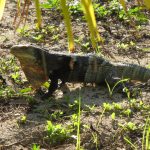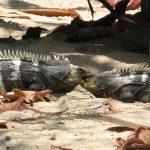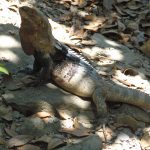Stats
Population: Less than 5,000 among 2 range areas
Size: Males average 9.5″ in length and 1.3 lbs in Cayos Cochinos, max up to 12.5″ length and 3.1 lbs. Males in Rio Aguán Valley are 2″ shorter and half the weight
Threats: Habitat destruction; Introduced predators; Over-exploitation for local consumption; Illegal international pet trade.

Species Information
- The Black-chested Spiny-tailed Iguana is endemic Honduras and occurs in two sub populations, the Rio Aguán Valley in northern Honduras and Cayos Cochinos off the Caribbean coast of Honduras.
- They inhabit tropical and subtropical dry forest and scrubland, which is under threat due to conversion to agriculture land in the Rio Aguán Valley.
- They are threatened also by illegal poaching of meat and eggs, despite being protected by a national ban on iguana hunting in Honduras. In Olanchito, Valle de Aguán, a festival exists in which the consumption of these iguanas is celebrated and is culturally significant.
- Cayos Cochinos is located in the Bay Islands Marine Park and the Iguanas are offered some protection on the islands, on the mainland they occur in the south of one protected area, Pico Bonito National Park, although protection is limited in this region.
- Management, monitoring, protection of habitat, environmental education and enforcement of protection laws are needed for the conservation of the species.





Geographic Distribution of the Black-chested Spiny-tailed Iguana, Ctenosaura melanosterna, in the Valle de Aguán, Honduras
Stesha Pasachnik, Edoardo Pineda, and Jeffrey Corneil
$6,950
There is currently a lack of information concerning all aspects of this species’ biology including knowledge of its actual range in the Valle de Aguán. This study, focusing on the distribution of C. melanosterna, was given the highest priority at the 2008 ISG meeting. Objectives are to create a potential distribution map targeting areas that need to be evaluated for occurrence, evaluate all potential areas of occurrence, collect natural history data on all populations found, create an actual distribution map, and make projections about the future distribution of C. melanosterna in the Valle de Aguán.
Geographic Distribution of the Black-chested Spiny-tailed Iguana (Ctenosaura melanosterna) in the Valle de Aguán, Honduras
Stesha Pasachnik and Edoardo Antunez
$6,050
Status and Conservation of the Black-chested Spiny-tailed Iguana, Ctenosaura melanosterna, in the Cayo Cochinos Archipelago
Chad Montgomery
$5,500
This project will provide support for the study the ecology, demography, population size, and genetic relatedness of Ctenosaura melanosterna on Cayo Pequeo and Cayo Grande to gather information necessary for the development of a management plan for the species.
Molecular Evaluation of the Ctenosaura melanosterna Clade
Stesha Pasachnik
$5,000
This project will use a molecular phylogenetic approach to evaluate species boundaries and define new boundaries if needed within the Ctenosaura melanosterna clade, to evaluate the degree and direction of introgression between the island endemic Ctenosaura bakeri and a wide ranging congener C. similis, and to date the colonization events of C. bakeri, C. oedirhina, C. similis, and C. melanosterna to the Bay Islands. In completing these goals conservation biologists and managers will be able to know where and how to target conservation efforts that will aid in the protection of four endangered species.

